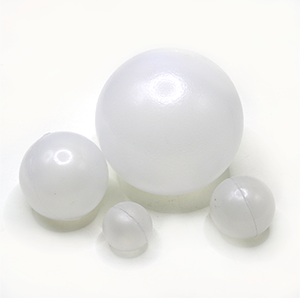COD Removal Efficiency of Hollow Floating Ball Packings
Release time:2025-04-09
Release time:2025-04-09
Technological Innovation: Breakthrough in Dynamic Biofilm Systems
Hollow Float Packing provides an ideal habitat for microorganisms by combining a three-dimensional porous structure and suspension fluidization characteristics. In the contact oxidation tank, the filler is continuously suspended under aeration, forming a dynamic contact pattern. This design not only enlarges the mass transfer area but also promotes the shedding of aging biofilm through the shear force of water flow and maintains the activity of the microbial community. Compared with the traditional fixed-bed filler, its suspension characteristics significantly improve the impact resistance of the system, which can quickly adapt to water quality fluctuations and form a composite degradation ecosystem.
Functional optimization: synergistic action of microbial communities
The pore structure of the filler enables the growth of microorganisms in different layers: the aerobic layer to decompose water-soluble organic matter, the parthenogenetic layer to remove nitrogen through denitrification, and the anaerobic micro-environment to degrade insoluble substances. Surface hydrophobic modification technology (special surface treatment) prevents clogging and pollutant contact efficiency so that the system remains stable during the rainy season and avoids the sludge expansion problem of the traditional process.
Application Scenario: Multi-discipline Adaptability Verification
In chemical wastewater treatment, a park has successfully reduced the COD concentration of oil-containing wastewater from 800mg/L in the influent to less than 150mg/L by adjusting the aeration and residence time. In municipal wastewater treatment, a plant increased shock load resistance by 30% by adding filler, and the effluent still stably meets the standard when it fluctuates by 50%. This effectiveness is due to the continuous renewal of microbial membranes in the fluidized state of the packing.

Industry Trend: Innovative Integration of Materials and Processes
The current development shows two major directions: the material field adopts graphene modification technology to improve low-temperature adaptability, and the process aspect combines with oxidation technology to improve COD removal rate significantly. The new manufacturing process reduces the cost by 20%, and the modular design shortens the installation cycle by 50%, and a project shows that the construction cost is reduced by 15%, and the operation energy consumption is reduced by 25%, which makes the competitiveness of small and medium-sized projects.
Technology Outlook: Low Carbon and Intelligent Path
The future will focus on low carbon, through optimizing the aeration strategy to reduce energy consumption; and the development of biodegradable materials to reduce pollution. Intelligent, embedded sensors to achieve dynamic adjustment of parameters, to promote the green transformation of the industry. Synchronous nitrogen and phosphorus removal technology reduces the use of chemicals and sludge production by 40%, creating conditions for resourceful treatment.
Conclusion
Hollow Floating Ball Packing promotes the transformation of sewage treatment to active control by structural innovation and functional optimization. Its synergistic microbial community and process integration capabilities for low-carbon, resource-based to provide a viable solution. With technological progress, the filler will become an important force in the upgrading of the water treatment industry.
RELATED INFORMATION

Customer Service Hotline
Tel/WeChat/WhatsApp:+8618079942828
E-mail/Zoom:jlee@pxrjhb.cn
Address: No. 1-269, Zone B, Industrial Park, Xiangdong District, Pingxiang City, Jiangxi Province
 Customer Service
Customer Service
Website construction:300.cn


